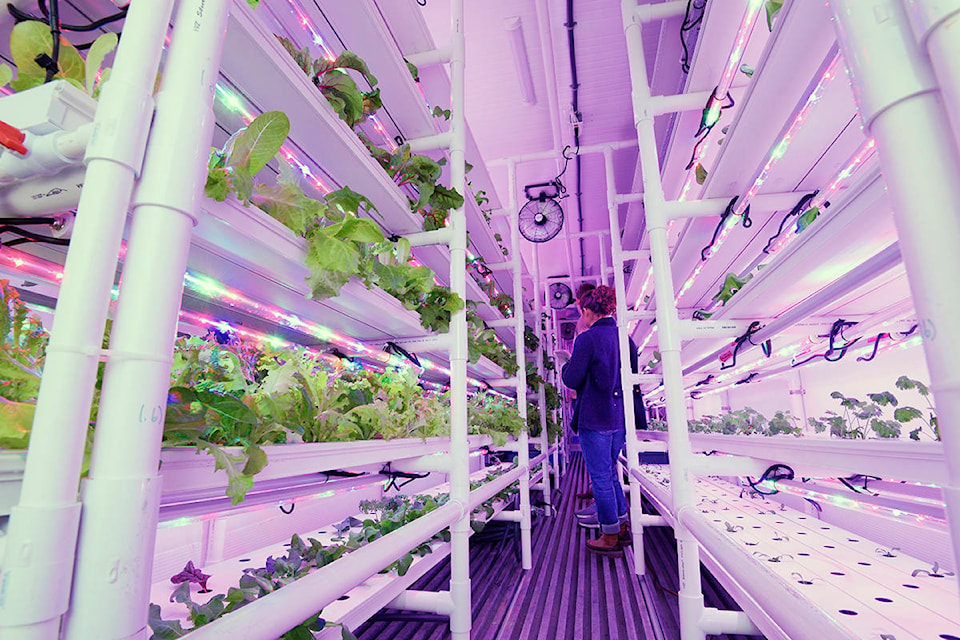Stepping into a CropBox feels like walking onto a Star Trek set.
The all-white interior of the long, narrow unit glows like it’s a sci-fi flight deck.
“They’re LED lights,” says Danny Ghul, gesturing to the hundreds of mini-lights shining down on rows of perfect leafy greens, sprouting from holes in smooth white shelves. “The reason they’re red, green and blue is those are the only values of the light spectrum that the plants need to produce.”
Guhl is the business development manager for Solvest — a solar energy company in Whitehorse that specializes in remote energy generation. Last year, Solvest became the Canadian distributor for the North Carolina-based company that developed CropBox — a refurbished shipping container that serves as a hydroponic farm.
One of Solvest’s contributions to the system is the PowerBox, a unit that stores solar energy so a CropBox can be maintained off-grid.
Next, it will “northernize” its test unit by increasing insulation from R20 to R60, so it can maintain growing conditions even in -45 C weather. Solvest will also add an Arctic entrance to make it easy for CropBox owners to harvest and package produce.
With a $150,000 price tag for a standard CropBox and $200,000 for a winterized version (plus an additional $220,000 if you want the PowerBox), this isn’t the kind of set-up your average backyard gardener can afford, but it’s easy enough for a beginner to operate, says Sabrina Clarke, CropBox operator for Solvest.
“It sounds gimmicky, but I came into this job having no hydroponic experience,” says Clarke, who’s also a chemical and environmental engineering student at McGill University. “And you get kind of all the nutrients that you need to grow, you get a manual saying ‘if you want to grow lettuce, have the water at this pH.’ So it’s really accessible to anyone who wants to learn.”
On June 7, Lana Selbee, operations director of YuKonstruct, toured the CropBox. She says YuKonstruct is looking at ways to offer hydroponics workshops in partnership with Solvest.
Clarke says the Kluane Lake Research Station has also expressed interest in testing a CropBox this winter. As well, representatives of mining sites have been in touch about the option to lease CropBoxes for temporary sites. And while Cold Climate Innovation at Yukon College won’t be directly involved in the day-to-day operations, CCI did provide funding for the project.
“This ticked a lot of our boxes,” says Eoin Sheridan, Project Officer at CCI, whose areas of interest include cold climate innovation, alternative energy, and food security in the North.
“There’s nothing like this in the Yukon yet. (CropBoxes) have been more or less successful in other places, but as yet there’s nothing operating in the Yukon,” he says.
Special conditions in the North, from its remote location, to its climate and soil conditions, all have implications when it comes to food production.
“This skips around that,” he says.
“This is part of a continuum of solutions.… It’s not a one size fits all solution, but it’s part of a broader solution.”
Guhl says that’s the hope.
“When you take produce 2,000 km up the highway, you lose some nutrition,” he says. “With the CropBox, not only do you only ship it up once, you can increase the shelf life of produce. You can add weeks.”
And, says Clarke, while there are no concrete numbers yet on what it will cost to power a CropBox for a year, the process is low-maintenance.
Seedlings are started in tiny compostable sponges, then transferred into one of the CropBox shelves. There, two 378-litre tanks circulate water to the plants. Because the water is recycled through the reservoirs, the CropBox uses around 100,000 litres annually compared to 10 times that in traditional farming.
Nutrients can be added to the water, depending on the balance needed for any given crop. The LED lights cycle on for 16 hours a day and off for eight, to mimic a natural cycle. Water and temperature can be monitored and controlled by way of smart phone.
So far, Solvest has seen one crop come to the point where it can be harvested. Lettuce, swiss chard, and water cress planted at the beginning of May are ready for harvest by the beginning of June.
Guhl says Clarke will try out other plants in the coming weeks, to see how quickly they grow, and what the optimal conditions are.
Contact Amy Kenny at amy.kenny@yukon-news.com
